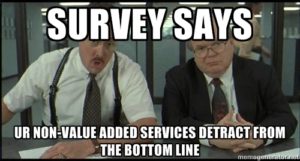 We are often reminded that words should be deliberate, and that sometimes words can hurt. In project management, these are applicable. More importantly, we need to be very conscious of the image that our words present. New projects are often opportunities to deepen the customer relationship. If all project stakeholders aren’t careful about the language they use, the customer or team can get the wrong impression.
We are often reminded that words should be deliberate, and that sometimes words can hurt. In project management, these are applicable. More importantly, we need to be very conscious of the image that our words present. New projects are often opportunities to deepen the customer relationship. If all project stakeholders aren’t careful about the language they use, the customer or team can get the wrong impression.
Project managers need to have a very clear picture of goals of the project, and the nature of the relationship. It is our job to set the tone of the project. This means if any language is being used that might derail the tone you are trying to set, it is critical for you identify it early, and reframe the conversation.
Many of my projects are data related, which means I spent a lot of time validating data and demonstrating our process to the business users to explain how we got from point A to point B. As we all know, users don’t like change so the introduction of a new system brings distrust until you can prove that you’ve done what was expected (specifically the data gets validated). It is not uncommon for me to hear “it’s wrong.” Probing into that phrase usually results in the business users conveying additional information that would change the methodology. “The data is wrong” in the context of a data project is never where you want to start the implementation. Sometimes I will find that there is an upstream issue that gets uncovered during the implementation. Yes, that is a problem that needs to be fixed. But had we not been in the middle of an implementation, you might not have realized you had the issue.
Another example is configurable software. Again, people are very caution of new software systems, especially ones that proclaim predictive or advanced functionality. The easiest way to convince people is to configure a test. However, too often, the response will be the “algorithm is wrong.” Is the algorithm really wrong? The output is exactly what the software tells it to do. So if a test was configured to “show the art of the possible” with limited information about the specific business or use case, there is a high probability that the outcomes will be unexpected.
“Unexpected” does not mean the same thing as “Wrong”
These words should not be used interchangeable. “Wrong” sets the tone with the business users that the system isn’t doing what it needs to do. This creates very negative emotions towards the project. “Unexpected” can be explained, adjusted and resolved. Working with your project team to resolve unexpected results can foster respect, and positive emotions towards the project and the software.

 Step 1: Critical to both processes is identify the value. Why is the customer engaging in
Step 1: Critical to both processes is identify the value. Why is the customer engaging in


 Engagement is not passively granted, but rather actively earned. As part of the project implementation, there needs to be special consideration given to figuring out how to keep users involved & engaged. Here are 3 options for continuing the conversation with the user community:
Engagement is not passively granted, but rather actively earned. As part of the project implementation, there needs to be special consideration given to figuring out how to keep users involved & engaged. Here are 3 options for continuing the conversation with the user community:

